Wedding jewelry traditions vary fascinatingly worldwide. You’ll find Indian mangalsutra necklaces, Chinese gold and jade pieces, and Western diamond rings all symbolizing commitment differently. Americans wear wedding bands on the left hand (the “vena amoris” tradition), while Russians prefer the right. Men’s rings gained popularity during WWII, and alternatives like colored gemstones are trending today. Religious customs add another dimension, from Jewish simple bands to Buddhist endless knots. These traditions reveal centuries of cultural significance beyond mere adornment.
Wedding Jewelry Traditions: 10 Tips From Around Earth
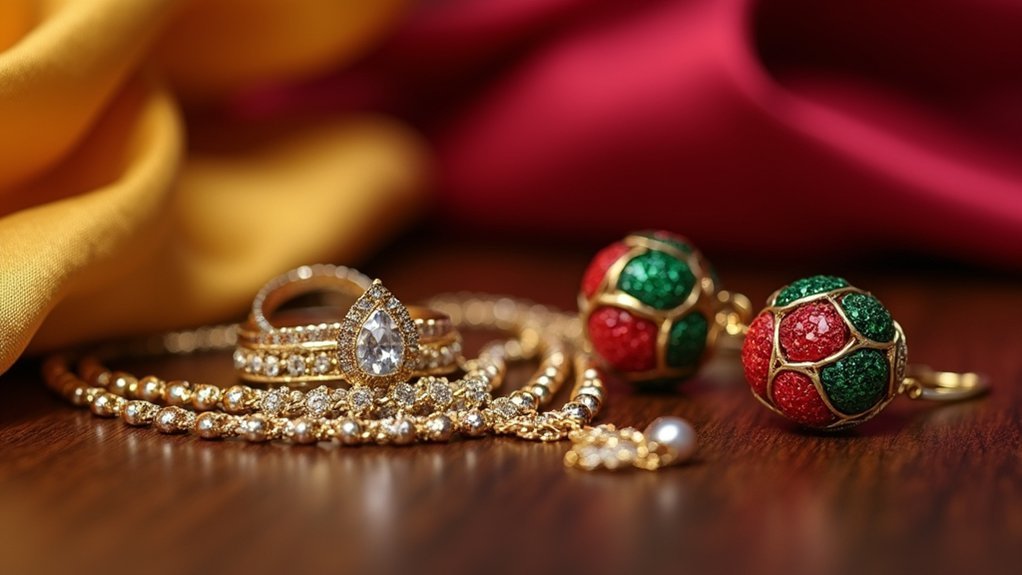
When planning your wedding, understanding global jewelry traditions can add meaningful depth to your celebration. Wedding jewelry traditions vary dramatically across cultures, offering rich symbolism you can incorporate into your own ceremony.
Consider Indian traditions where mangalsutra necklaces and toe rings signify marital status. Or explore Chinese customs featuring gold and jade pieces that represent prosperity. If you’re drawn to Western traditions, diamond engagement rings symbolize eternal commitment, while wedding rings exchanged during the ceremony reflect your unbroken bond.
You might appreciate Ireland’s Claddagh ring, which cleverly indicates relationship status through its orientation. For something truly unique, look to Celtic endless knots or consider modern alternatives like matching tattoos.
Whatever you choose, your wedding jewelry can honor heritage while expressing your personal connection.
Understanding Ring Placement: Left Hand or Right?
When you exchange rings on your wedding day, the hand you choose reflects deep cultural traditions that vary worldwide—with Americans, French, and Canadians favoring the left hand while Germans, Russians, and others opt for the right.
The left-hand tradition stems from ancient Egypt’s belief in the “vena amoris,” a special vein connecting the fourth finger directly to the heart.
Though these practices have historically been rigid, you’ll now find couples embracing either tradition based on personal preference rather than strictly adhering to cultural norms.
Global Placement Variations
Although wedding rings symbolize commitment worldwide, their placement varies significantly across cultures. In the U.S., France, and Canada, you’ll find wedding rings on the fourth finger of the left hand—following the ancient belief that this finger contains a vein running directly to the heart.
However, if you travel to Germany, Russia, India, or Norway, you’ll notice wedding bands adorning the right hand instead. These global variations reflect deep cultural practices with roots in religious traditions and national customs.
While left-hand placement originated from Roman traditions, right-hand customs often stem from regional interpretations of matrimony.
Understanding these differences enriches your appreciation of wedding traditions. As you encounter diverse cultural practices around ring placement, you’ll recognize how this simple symbol carries unique significance across different societies.
Historical Vein Belief
The historical belief about a special vein running from the fourth finger of the left hand directly to the heart has shaped wedding ring traditions for centuries.
This ancient Roman concept established what we now recognize as Western traditions for wedding jewelry placement.
When you’re deciding where to wear your wedding rings, consider these cultural perspectives:
- In the U.S., France, and Canada, the left hand’s fourth finger is traditional due to the heart-connection belief
- Germany, Russia, and Norway typically favor the right hand for wedding bands
- Your family heritage might influence your preference between left or right
- Personal meaning can supersede cultural norms when choosing your ring finger
Understanding these differences enriches your appreciation for wedding customs across different societies and helps you make a more meaningful choice.
Shifting Modern Practices
While ancient beliefs established traditional ring placement, modern wedding jewelry practices reflect our increasingly interconnected world.
You’ll notice distinct cultural variations in how couples wear their wedding rings today. If you’re in the U.S., France, or Canada, you likely follow the left-hand tradition, specifically the fourth finger, stemming from the ancient Roman belief about a vein connecting to the heart.
However, if you’re celebrating in Germany, Russia, India, or Norway, you’ll observe rings proudly displayed on the right hand.
Men’s wedding rings represent another evolving tradition, becoming widely popular only during World War II and now worn by about 80% of married American men.
These differences aren’t just about aesthetics—they represent deep cultural traditions and values surrounding marriage commitments.
The Evolution From Economic to Romantic Symbolism
Throughout history, wedding jewelry has undergone a remarkable transformation from practical economic arrangement to profound emotional symbol.
What began as a groom’s demonstration of financial stability has evolved into a universal expression of eternal love.
You might be surprised to learn how wedding rings and engagement rings have changed in meaning:
- Ancient grooms offered purses of gold coins to prove they could provide financially
- Men’s wedding rings gained popularity during WWII as symbols of connection while separated
- The traditional exchange of rings shifted from representing economic security to emotional bonds
- Today’s wedding jewelry celebrates partnership and commitment rather than financial contracts
This evolution reflects broader cultural changes in how we view marriage—from practical alliance to a celebration of love and devotion between equals.
Men’s Wedding Rings: A Modern Tradition
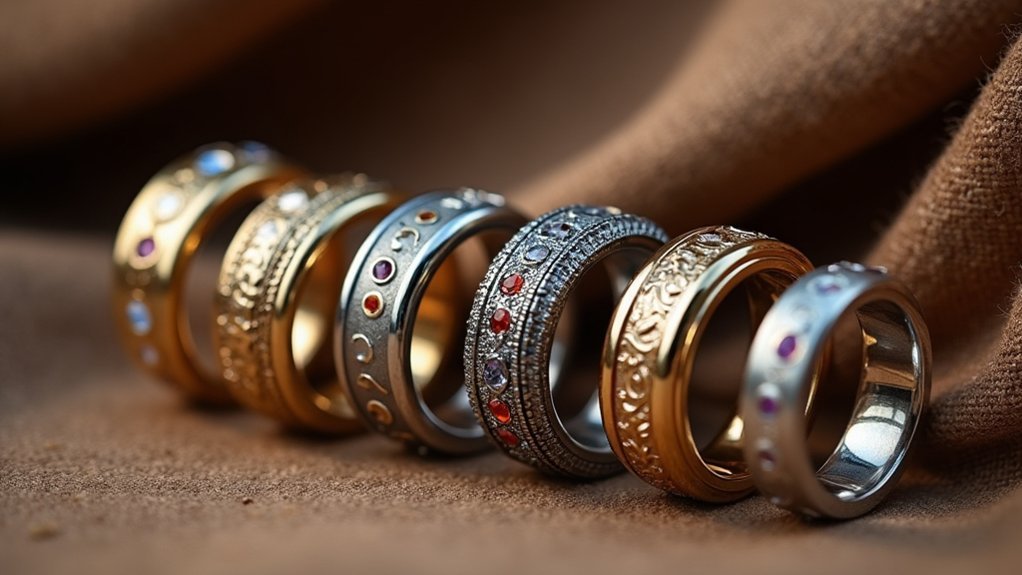
While women have worn wedding rings for centuries, you’ll find that men’s wedding bands only became commonplace during World War II, when soldiers wanted a visible symbol of their commitment while separated from their wives.
Today’s statistics show dramatic regional differences in this tradition, with approximately 80% of American men wearing wedding rings compared to lower percentages in some European and Asian countries.
Your choice to wear a wedding band connects you to this relatively young tradition that transformed from a wartime practice into a widespread symbol of partnership and commitment.
Wartime Connection Surge
Although men’s wedding rings existed before the 1940s, they surged in popularity during World War II when soldiers deployed overseas sought tangible symbols of their marriage bonds. This practice transformed from uncommon to mainstream, with approximately 80% of American men now wearing wedding rings as a symbol of commitment.
You’ll find this wartime shift fascinating for several reasons:
- Soldiers wanted physical reminders of their loved ones while separated
- The tradition continues today, long after the war’s conclusion
- Wedding rings provided emotional comfort during dangerous deployments
- Historical changes in gender dynamics reinforced the practice’s acceptance
Unlike engagement rings, which remain primarily a women’s tradition in the U.S., men’s wedding rings have become a normalized cultural expectation. This shows how traditions evolve differently across genders.
Global Wearing Patterns
When examining global customs surrounding men’s wedding rings, you’ll discover fascinating geographical variations that reflect cultural attitudes toward marriage symbols. In the U.S., about 80% of men now wear wedding rings—a tradition that gained momentum during World War II as soldiers sought tangible connections to their spouses during separation.
Unlike women’s bridal adornments, men’s wedding rings tend toward simpler designs, prioritizing comfort and personal style over ornamentation.
You’ll notice that while wedding bands for men have become mainstream, male engagement rings haven’t followed suit in American culture. This contrasts with some international traditions where men participate in both engagement and wedding ring customs.
The evolution of men’s wedding rings demonstrates how marriage symbols adapt to changing social expectations while maintaining their emotional significance.
Beyond Diamonds: Alternative Engagement Jewelry
As traditions evolve, couples today are increasingly seeking engagement jewelry that reflects their unique personalities and values rather than conforming to conventional diamond-centric expectations.
Looking beyond conventional options reveals a world of alternative engagement rings that celebrate both individuality and cultural practices.
You’ll find a growing trend toward:
- Colored gemstones and unique materials like wood or ceramic that tell personal stories
- Traditional cultural elements, such as the Hindu bichiya (toe rings), offering meaningful alternatives
- Ethical choices including lab-created diamonds and recycled materials for environmentally-conscious couples
- Promise rings with simpler designs that symbolize commitment before formal engagement
Celebrating Milestones: Global Anniversary Adornments
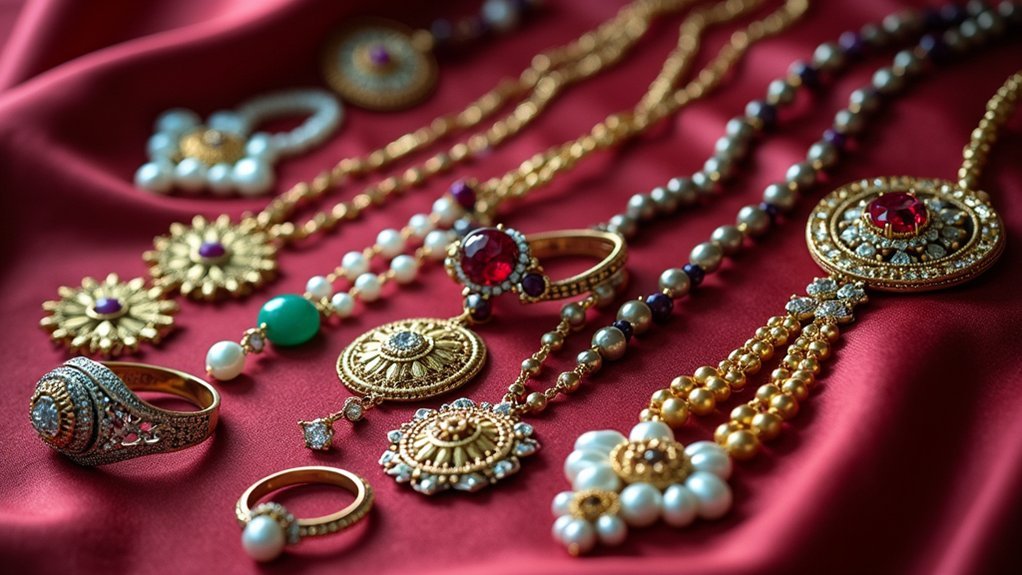
Celebrating love’s endurance through meaningful jewelry has evolved into distinct traditions across cultures worldwide. Romania’s silver anniversary custom stands out, where couples exchange silver bands to wear alongside their original wedding bands on their 25th anniversary.
| Country | Anniversary | Jewelry Tradition |
|---|---|---|
| Romania | 25th | Silver anniversary bands |
| Global | 60th | Diamond celebration pieces |
| Various | Milestone years | Gemstones matching anniversary year |
You’ll find precious metals feature prominently in anniversary jewelry traditions, symbolizing the strength of long-term commitments. While gold remains the standard for wedding bands, many cultures incorporate additional rings or complementary pieces to mark relationship milestones. Consider adopting these meaningful customs to commemorate your own journey, creating tangible reminders of your shared history and ongoing commitment.
Sacred Symbols: Religious Significance in Wedding Jewelry
Religious beliefs shape wedding jewelry traditions around the world, with each faith incorporating meaningful symbols that reflect spiritual values. These sacred adornments carry profound meaning beyond their aesthetic appeal.
- In Judaism, a simple gold band serves as the quintessential Wedding Ring Tradition, placed on the right index finger to honor ancient customs and bring good luck to the marriage.
- Hindu brides wear the sacred necklace called mangalsutra, often featuring black beads for protection and gold pendants symbolizing the couple’s eternal bond.
- Christian ring exchange ceremonies became formalized in the 11th century, with specific blessings that transformed simple bands into symbols of covenant.
- Buddhist couples often incorporate the endless knot into their wedding jewelry, representing the interconnectedness of spiritual paths and ensuring good fortune.
Cultural Designs That Tell Stories: The Claddagh and Beyond
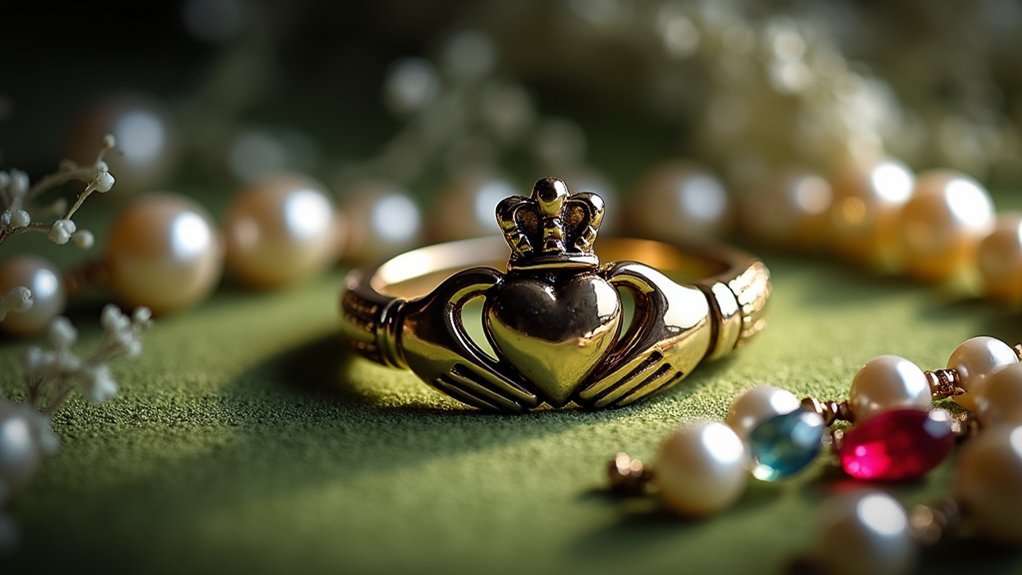
Cultural wedding jewelry extends far beyond mere adornment, with iconic designs serving as silent storytellers of heritage, values, and romantic status. The Irish Claddagh ring exemplifies this perfectly, with its hands (friendship), heart (love), and crown (loyalty) carrying deep symbolic weight.
This distinctive wedding jewelry reveals the wearer’s relationship status through positioning—heart facing inward for commitment, outward for availability. Originating from Galway’s fishing village of Claddagh, its legacy traces back to goldsmith Richard Joyce in the 17th century.
Beyond Ireland’s shores, you’ll find equally meaningful cultural designs worldwide. Celtic knots represent eternal devotion while Indian mangalsutras symbolize marital unity.
Each piece carries centuries of tradition, allowing modern couples to wear their cultural narratives and values on their fingers or around their necks.
Promise Rings: Pre-Engagement Commitments Across Cultures
The subtle promise ring occupies a meaningful space between casual dating and formal engagement, serving as a tangible symbol of commitment before marriage plans solidify. When you’re ready to express your devotion without proposing, these commitment tokens offer the perfect solution.
- Unlike engagement rings, promise rings typically feature simpler designs with smaller stones, making them both meaningful and practical for everyday wear.
- You’ll find historical significance in these jewelry pieces, dating back to 16th-century poesy rings inscribed with romantic verses.
- In Hindu traditions, commitment symbols may appear as bangles or toe rings rather than finger jewelry.
- You’re part of a growing American trend if you choose a promise ring, as their popularity has surged over the past decade.
Legal Considerations: When Jewelry Exchanges Go Wrong
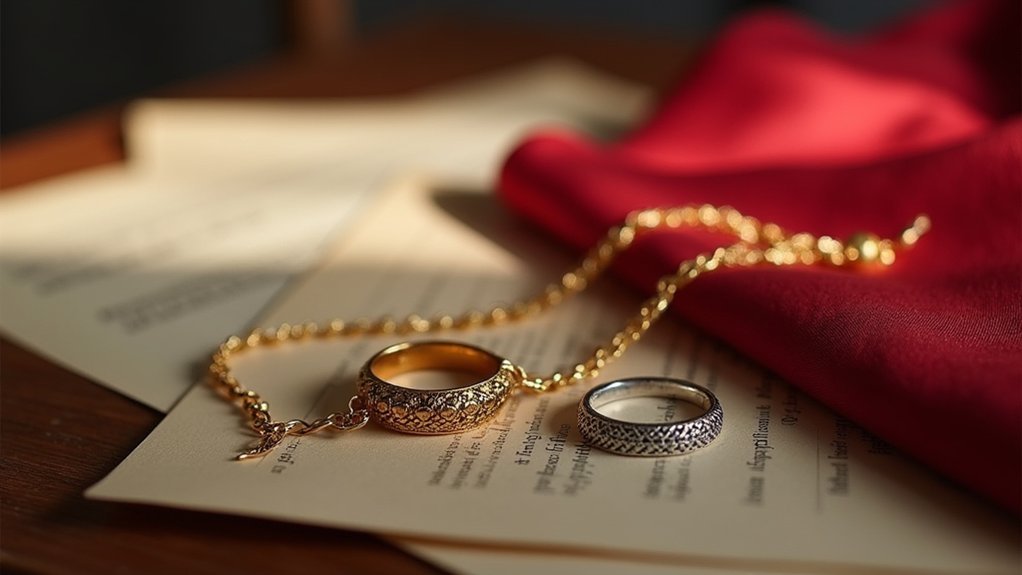
While exchanging rings symbolizes love and commitment, these sentimental gestures occasionally transform into contentious legal battles when relationships dissolve.
In the U.S., engagement rings are typically considered conditional gifts, meaning you can reclaim the ring if the wedding doesn’t happen—regardless of who ends the relationship.
However, if you give the ring on Valentine’s Day, courts might view it as an unconditional gift.
Timing matters: a Valentine’s Day ring may legally transform from a conditional promise to an outright gift.
The rules differ internationally. In England, men who break engagements generally can’t reclaim the wedding ring, unlike their American counterparts.
To avoid these legal considerations, have clear conversations about your expectations when exchanging engagement rings.
Understanding the potential implications could save you emotional and financial stress if your relationship doesn’t proceed to marriage.
Frequently Asked Questions
What Culture Uses Bangles Instead of Wedding Rings?
In Hindu culture, you’ll find bangles used instead of wedding rings. You’ll see married women wearing them as marital symbols, especially in regions like West Bengal where they’re essential wedding jewelry representing prosperity and commitment.
Which Cultures Do Not Use Wedding Rings?
You’ll find the Maasai in East Africa, certain Indigenous North American tribes, traditional Hindu communities, the Namibian Himba tribe, and some rural Chinese ethnic minorities don’t use wedding rings, preferring other symbolic adornments instead.
What Is the American Wedding Ring Tradition?
In America, you’ll wear your wedding ring on the left hand’s fourth finger. You’ll exchange rings as a symbol of love, with women often receiving an engagement ring first, followed by the wedding band.
What Did Native Americans Use for Wedding Rings?
Native Americans traditionally used natural materials like leather, bones, and stones for wedding rings. You’ll find they also crafted rings from silver and gold, often incorporating turquoise and meaningful symbols representing their spiritual beliefs.
In Summary
Wedding jewelry isn’t just about sparkle—it’s a tapestry of cultural stories woven through generations. Whether you’re honoring traditions or creating your own, remember that these symbols carry both emotional and practical weight. As you exchange rings or other meaningful pieces, you’re not just participating in a ceremony—you’re joining a global conversation about commitment that’s been evolving for centuries.





Leave a Reply